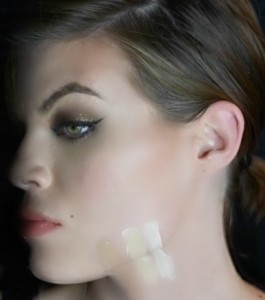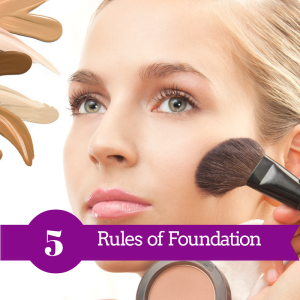Can you get a perfect and flawless makeup foundation? Can you really achieve flawless looking skin and still look like you’re wearing nothing at all?
With a few rules to follow you can get the flawless foundation you are looking for!
Choose the Right Product
With so many new foundation options on the market today we have a plethora of products to choose from, so using the right product for your specific skin type and skin tone is very important. And yes, there is a difference between skin type and tone!
What is your skin type? This is the question every beauty expert will ask you at a consultation. Do you have oily, dry or combination skin? This question is very important and is a huge factor in choosing the right foundation product to use on your skin. Make sure that you know your skin type before you go to the store or to a beauty expert. Below is a list of foundation products and how they relate to different skin types.
Mineral Powder Foundation: Used on normal, oily or combination skin. Mineral powder foundations give a medium coverage with a matte finish and will have an oil absorbing effect to keep you looking fresh and oil free all day. The downside of a powder foundation is that they can dry out your skin, don’t provide as much coverage as liquid foundation and can enhance the look of wrinkles.
Liquid Foundation: Used on normal, dry and aging skin. Liquid foundations give a medium to full coverage depending on the product and give the skin a dewy appearance as they help to conceal skin imperfections and discolorations. They provide more coverage than a powder and as an added bonus they often contain emollients to help nourish the skin while they do double duty as a foundation. Liquid foundations are the most popular foundation product on the market.
Cream Foundation: Used on all skin types. Cream foundations usually provide total coverage and often times can be the answer to those skin conditions we are trying to conceal. Cream foundations usually come in a compact form and provide the best coverage of all the foundation options as they can hide many skin flaws such as birth marks, acne scars and all other manner of skin conditions. The downside of a cream foundation is that if not applied properly it can look caked on or too heavy.
Select the Right Color
Skin tone does not refer to the shade of your skin but to the undertones or pigmentation of your skin, it is the color that shows through from underneath the skin’s surface and determines whether your skin tone is cool, warm or neutral. So while you may get a bit darker in the summer or lighter in the winter your undertone does not change. That being said, make sure you know if you are warm tone or a cool tone before you make your foundation purchase. Here is a great site to help you determine your skin tone. Determine your skin tone
Selecting the right color for your skin tone is probably the most important makeup decision you will make. If you choose a color that’s to light you will look ghostly if it’s to dark your skin will look like a mask so be sure you choose carefully. Matching your foundation to the inside of your wrist is a myth, you do want to match your foundation to your cheek and jaw so use this trick to get the perfect match. Run a strip of foundation from your lower cheek down to your neck if it blends in and is almost invisible then that is your perfect match. If it’s to light or too dark then you need to test more colors.

Use the Right Application Tool
This may seem like a non-starter for some but for others this is a bit trickier and knowing the right application tool to use to apply your foundation is very important, even if those tools are your fingers.
Mineral powder foundations will come with a powder applicator to dust on your foundation but we prefer a puff brush that can evenly disperse the powder and get you the best coverage.
Liquid foundations don’t come with applicators but can be applied in a number of ways.
- Brush: Use a large firm dense puff brush to get an even and lightweight finish, creating an airbrushed look.
- Fingers: Use your fingers, this will warm up the product and make it easy to apply on the face, just be sure to use a blending sponge after you apply it, this will minimize lines and missed areas.
- Sponge: Use a beauty blender sponge or bud to buff and blend your foundation on your face but first make sure to dab the foundation all around your face using your finger tips.
Cream foundations come in compacts usually with a sponge or blending applicator to get even coverage. Be sure to dab on face first in all areas to be covered and then use circular blending motions making sure to cover the entire face.
Blend-Blend-Blend
If matching your skin tone is the most important part of foundation then blending it on the face is the second most important detail! Blending and fading your foundation is what separates the pros from the amateurs, you never want to walk away from your mirror with a line between your chin and your jawline, so be sure to pull that foundation down under the chin and fade into the jaw.
Prep and Prime
With all there is to know about foundation it’s just as important if the canvas we lay our foundation on was prepped to give us the most bang for our buck. Prepping your face means your skin is clean, dry and moisturized using an SPF moisturizer, then be sure to apply your favorite face primer before every foundation application. A primed face will keep your makeup looking fresh all day long and you will be putting your best face forward.
To learn more about the fundamentals of foundation join us for our Foundation Workshop

This design is spectacular! You certainly know how to
keep a reader entertained. Between your wit and your videos, I was almost moved to start my own blog (well,
almost…HaHa!) Excellent job. I really enjoyed what you had to say, and more than that, how
you presented it. Too cool!
I don’t think the title of your article matches the content lol. Just kidding, mainly because I had some doubts after reading the article.
pharmacy support group viagra: how to start a pharmacy store – fry’s pharmacy
cheap viagra in usa VGR Sources buy viagra cheap
cost for viagra prescription: VGR Sources – can i buy viagra in usa
where to buy female viagra uk: VGR Sources – cheap sildenafil canada
buy generic viagra 25mg: VGR Sources – viagra canada
https://vgrsources.com/# buy viagra online india 100mg
cheap viagra.com VGR Sources viagra miami
online viagra soft: sildenafil 25 mg online – discount viagra canadian pharmacy
online viagra from india: VGR Sources – sildenafil cost usa
viagra usa prescription VGR Sources buy generic viagra in us
canadian viagra online: how to get viagra pills – viagra without presc uk
brand name viagra canada: VGR Sources – sildenafil 100mg gel
buying viagra in us: VGR Sources – viagra for sale in canada
https://vgrsources.com/# viagra soft tabs uk
sildenafil online purchase in india: viagra 100mg price in usa – viagra for women sale
cost viagra 100mg generic sildenafil otc viagra 200mg online
viagra online canadian pharmacy paypal: VGR Sources – viagra for sale fast shipping